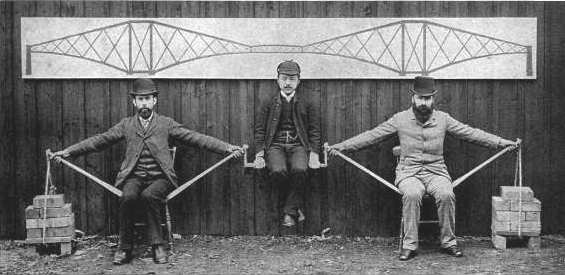Or search by topic
Number and algebra
Geometry and measure
Probability and statistics
Working mathematically
Advanced mathematics
For younger learners
More Bridge Building



This problem extends the introductory Bridge Builder problem. You will probably first need to attempt that problem.
Our bridge building engineer wishes to consider the problem of making a longer bridge with $n$ segments along the base.
For a bridge of even length, a single weight 2W is to be hung from the centre. For a bridge of odd length, two weights W will be hung from either side of the central strut, as in the following diagrams:
Part 1) Which lengths of bridge can be created such that there is no net force on any of the pin joints? Try to solve this problem using only vector methods.
Part 2) Which struts do you think will be under most tension/compression. Perform a calculation to see if you are correct.
Part 3) (Very difficult open investigation) Investigate the effects of adding an extra layer of triangles to the top of the bridge or changing the configuration of the supports. Which configurations can you make which can be created with zero net force at all of the joints?
For inspiration in creating these structures you might want to look at the Forth Bridge, in Scotland (see, for example, the Forth Bridge section on the Network Rail website), which is built using the following basic framework structure:

In 1887 the designer of the Forth Bridge, Benjamin Baker, modelled the key principles involved in the bridge's design using two piles of bricks, two ropes, four wooden poles and three people and a seat. The man in the centre is very easily supported as his weight is distibuted throughout the structure.
Extension: The Forth Bridge uses a criss-cross design. Can you work out how the forces are distributed amongst all of its supports? Which parts of the bridge experience the greatest tensions and compressions?
You may also like
Lunar Leaper
Gravity on the Moon is about 1/6th that on the Earth. A pole-vaulter 2 metres tall can clear a 5 metres pole on the Earth. How high a pole could he clear on the Moon?
Wobbler
A cone is glued to a hemisphere. When you place it on a table in what position does it come to rest?
Bridge Builder
In this short problem we investigate the tensions and compressions in a framework made from springs and ropes.

